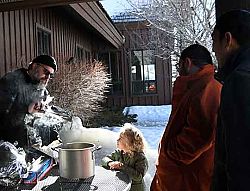The tradition of receiving ashes at Lent

SALT LAKE CITY — The 40 days of Lent begin with Ash Wednesday. Although it is not a holy day of obligation, the chance to mark the season of repentance by receiving ashes on the head brings Catholics and non-Catholics alike to church for the ritual.
“People love the idea of Ash Wednesday. I think there’s something inherently anthropological about the idea of on a certain day at a certain time – Lent – we really take seriously the idea of conversion,” said Father Christopher Gray, pastor of Our Lady of the Assumption Parish in Park City.
The Church doesn’t proscribe great detail about how the ashes are to be distributed. In some places, like the United States, the ashes typically are traced on the forehead. In other countries, they are sprinkled on top of the head.
Last year, because of the pandemic, the Vatican’s Congregation for Divine Worship and Sacraments specifically recommended that ashes be distributed only by sprinkling. This year, in the Diocese of Salt Lake City, because of the pandemic, Bishop Oscar A. Solis has said that ministers are to distribute ashes by either method, as the recipient requests.
Ashes are a sign of penance and are considered sacramentals, which the Catechism defines as “sacred signs which bear a certain resemblance to the sacraments, and by means of which spiritual effects are signified and obtained through the prayers of the Church.”
Lent is a penitential season when Christians are called to 40 days of prayer, fasting and almsgiving to make themselves ready to celebrate the Lord’s Resurrection at Easter. This preparation is intended to bring about “a true inner conversion of heart as we seek to follow Christ’s will more faithfully,” the U.S. Conference of Catholic Bishops states.
For Ash Wednesday, some parishes make their own ashes. At Our Lady of the Assumption Parish, Fr. Gray incorporated the burning of ashes into a social event for the Young Families Ministry. On Feb. 19, parishioners gathered for hot cocoa and games as Fr. Gray burned some palm branches that had been set aside last year on Palm Sunday. Parishioners also brought the palms they had taken home last year.
The event was “a perfect reminder that life in church is fun,” Fr. Gray said, adding that such gatherings lead to catechesis because they bring up questions about the sacramentality of the Church, symbolism and sacramentals.
“Blessed things are important,” Fr. Gray said, “and we’re also showing that it takes care to do it. It’s the kind of catechesis that I think is the best in the sense that it doesn’t require ‘here, sit in class and I’ll tell you things.’ No, no, no. Watch, take part in and see that these things matter.”
For the parents who brought their children, the day was a chance to socialize with each other as well as an opportunity for catechesis, said Taylor Buckley, a member of the parish council who has two children, ages 5 and 10 months.
After the children watch the palms being turned into ash, “it’s a lot easier when Ash Wednesday comes around” and she has a conversation with her 5-year-old about the ashes being traced on the forehead, Buckley said.
“It’s also a great connection to Palm Sunday,” when they receive the palms from which the ashes are made, and “allows us to connect all the liturgical seasons together,” she said.
Olivia Ptak, another parishioner, agreed. “It ties everything together – it’s not just some random dirt that goes on their head on Ash Wednesday.” In fact, last year on Ash Wednesday, her oldest child told her about the ashes, “We saw that happen,” she said.
© Copyright 2025 The Diocese of Salt Lake City. All rights reserved.

Stay Connected With Us